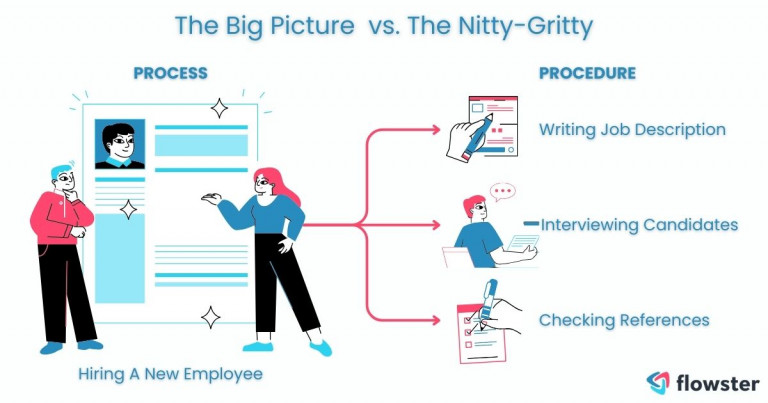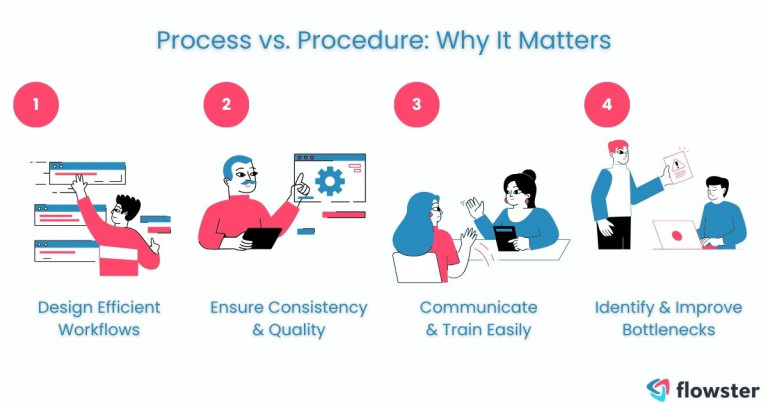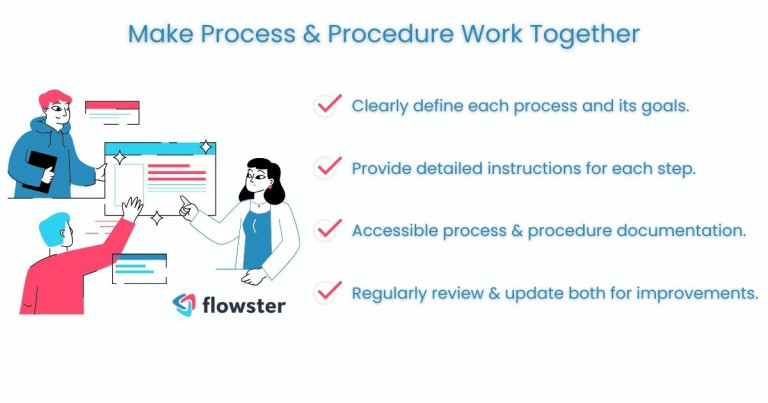In the dynamic world of business, efficiency and consistency are paramount. This is where understanding business processes and procedures becomes crucial. Though these terms are often used interchangeably, they play distinct roles in achieving desired outcomes. The difference between process and procedure is not just semantic; it’s foundational to streamlining business operations. In this article, we’ll dive deep into their distinctions, shedding light on why each is important and how they can be optimized for efficient processes.
Article Outline
Key Differences Between Process and Procedure
Diving into the heart of operational efficiency, understanding the key differences between process and procedure is crucial. Let’s unveil the distinct roles each plays in the tapestry of business operations, setting the stage for strategic execution and tactical precision.
Definition:
A process is an overarching series of tasks aimed at accomplishing a specific goal that is integral to business operations. It’s the strategic pathway for achieving a desired outcome, where document processes serve as a formal record of these steps.
Conversely, a procedure zeroes in on the specifics, offering detailed instructions for executing a singular task within a process. It’s the how-to guide to ensuring tasks are performed consistently and correctly, often detailing complex procedures to minimize human error.
Scope:
While processes—including both processes that support processes and those that drive core business functions—provide a bird’s-eye view of how various tasks and departments interlink, procedures drill down to the minutiae. They outline the exact steps needed for a task, focusing on precision and uniformity.
This strategic versus tactical distinction is the key difference between business processes and procedures, highlighting their closely related yet distinct roles in achieving business objectives.
Flexibility:
Processes inherently allow for adaptability, accommodating changes in approach to reach the end goal and eliminate waste. This flexibility supports efficient processes by adjusting to evolving business needs. On the flip side, procedures are more rigid, establishing a fixed sequence of actions with little room for deviation, which is crucial for tasks where consistency and accuracy are non-negotiable.
Understanding these key differences is vital for designing business processes that are both strategic and operational, ensuring that each step, supported by precise procedures, moves the organization towards its goals efficiently and effectively.

Importance of Clear Distinction Between Process and Procedure
Recognizing the key differences between processes and procedures is fundamental for several reasons, impacting how businesses can achieve efficiency and quality.
Designing Efficient Workflows:
By distinguishing between the overarching flow (processes) and the specific actions needed (procedures), businesses can create streamlined operations. Process maps guide the strategic layout, while procedures ensure each step is executed with precision, promoting efficient processes.
Ensuring Consistency and Quality:
Procedures play a crucial role in standardizing actions within processes, reducing human error, and maintaining quality. This clear distinction helps achieve uniform outcomes, essential for reliability and customer satisfaction.
Facilitating Communication and Training:
A clear understanding of processes and procedures enhances communication within business teams. It ensures everyone knows their role and how their tasks fit into the larger picture, making training more effective and improving team cohesion.
Identifying and Improving Bottlenecks:
With a clear framework of processes and procedures, businesses can more easily identify inefficiencies or bottlenecks. Analyzing processes helps pinpoint where delays occur, while scrutinizing procedures can reveal steps that may be streamlined or automated through process automation.
This clarity between processes and procedures is not just about semantic precision; it’s about creating a foundation for business operations to thrive. By demarcating the strategic from the tactical, businesses can foster environments where continuous improvement is not just a goal but a reality, leading to efficient processes that drive success.

Working Together: How Processes and Procedures Complement Each Other
Despite their differences, processes and procedures are inherently interconnected, each playing a vital role in the seamless operation of business activities. Their synergy is crucial for fostering an environment where efficiency and effectiveness are paramount.
Supporting Effective Execution:
Procedures are the backbone of successful process execution, providing the detailed steps necessary for each task within a process. This detailed guidance ensures that every component of a business process is carried out with precision, contributing to the overall success of business operations.
Integrating Seamlessly:
For business processes to function optimally, integrating processes and procedures is essential. This involves creating process maps that outline the steps of a process and the specific procedures that detail how those steps are executed. Such integration ensures clarity and coherence, enabling business teams to understand their roles and responsibilities clearly.
Enhancing Communication and Collaboration:
The complementary nature of processes and procedures enhances internal communication and collaboration. By defining the big picture (processes) and the specifics (procedures), everyone in the organization can see where they fit in the larger scheme of things, fostering a sense of purpose and teamwork.
Facilitating Continuous Improvement:
The dynamic interaction between processes and procedures allows for continuous monitoring and improvement. As business operations evolve, procedures can be refined to support changes in processes, ensuring that the organization remains agile and can adapt to new challenges and opportunities.
In essence, the relationship between processes and procedures is not one of competition but of collaboration. Each element supports and enhances the other, creating a holistic framework that drives business operations towards achieving efficient processes and desired outcomes. Embracing this interplay is key to optimizing performance and realizing strategic business goals.

Conclusion: Leveraging Process and Procedure Distinctions
Understanding the nuanced difference between process and procedure is more than just academic—it’s a strategic tool for business optimization. This clarity is crucial for crafting efficient processes supported by precise procedures, each step reflecting a move towards overarching business goals.
The interplay between processes and procedures enhances operational efficiency, fosters teamwork, and promotes continuous improvement. By recognizing their distinct yet complementary nature, businesses can streamline operations, improve consistency, and adapt more swiftly to market changes.
In essence, embracing the distinctions and synergies between processes and procedures is key to achieving operational excellence. It’s a foundational strategy that drives not just efficiency and productivity but also positions businesses for sustainable growth and success in a competitive landscape
Transform Your Business with Flowster's AI-Driven Automation
Need an easy way to create and document processes?
Flowster allows you to easily create standard operating procedures and document processes using AI, or you can browse our library of pre-built templates in the Flowster Marketplace.
Do you require assistance? Use our “Done for You” services to have our quality and improvement specialists design custom workflows for you.




